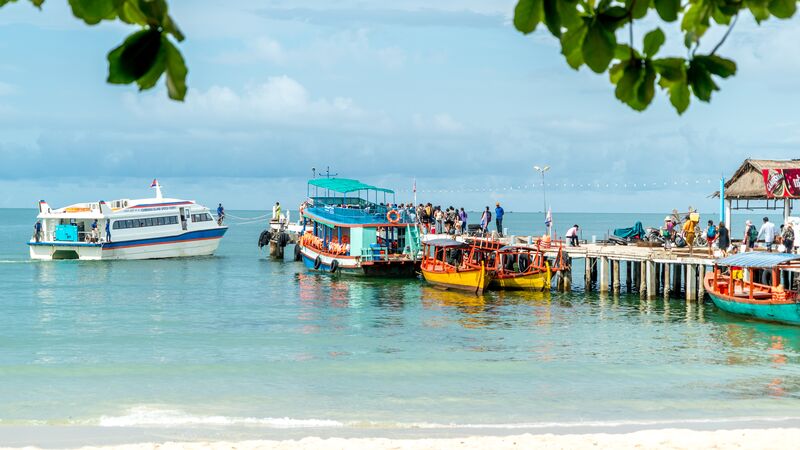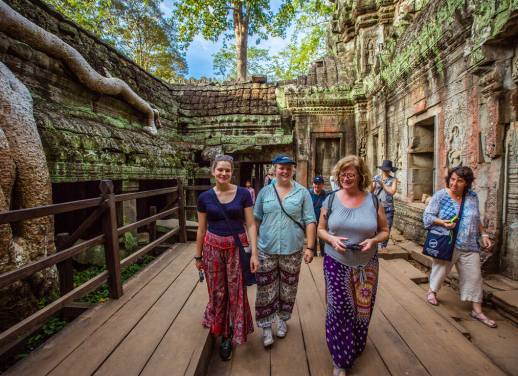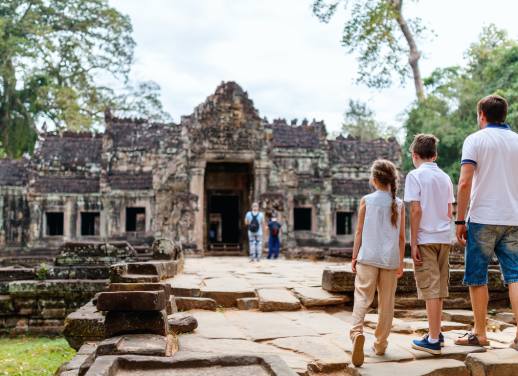If you want to see the face of overtourism, take a plane to Phnom Penh and catch a bumpy five-hour bus to Sihanoukville – a once-sleepy town on a little peninsula in the Gulf of Thailand. Sihanoukville is the jewel of Cambodia’s tourism industry. Or at least it used to be.
If you visited Sihanoukville five years ago, you might not recognise it today. The town has been swamped by foreign investment and tourism, mauled by construction. In fact, we’ve just made the difficult decision to stop visiting Sihanoukville altogether. As of this year, it no longer appears on Intrepid’s Cambodian itineraries, which is a terrible shame on so many levels.
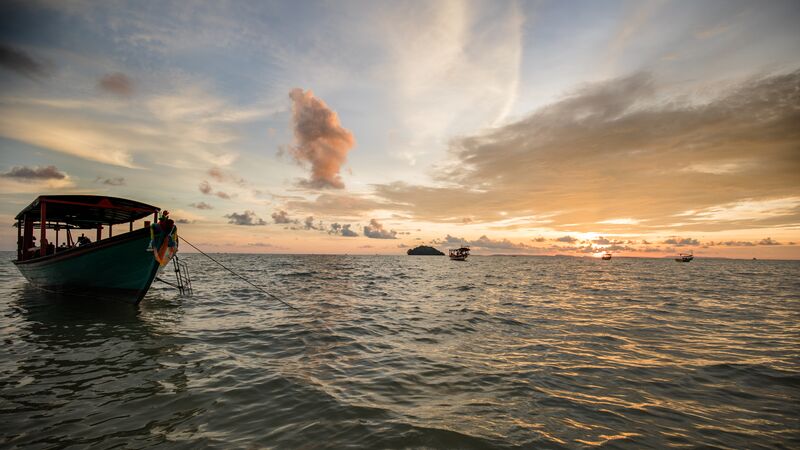
Sihanoukville used to look like this. Photo by Zahra Saleki.
For the vast majority of its history, nobody paid Sihanoukville much attention. The city doesn’t have any proper waterways, so during the Angkor Empire, most trade ran out of O Keo in the Mekong Delta. Sihanoukville was just a little peninsula, sticking out into the Gulf of Thailand, surrounded by jungle-covered hills and a string of golden beaches. It was only after Cambodian independence in 1954 that the government decided to build a port here; the deep water and easy access made Sihanoukville the logical choice. And when the Khmer Rouge fell in 1979, Sihanoukville became one of Cambodia’s economic success stories: a bustling trade town and fishing village, which slowly morphed into the country’s favourite seaside resort.
We started coming here back in 2007. At that time, Sihanoukville was still a blip on the average tourist’s radar. Serendipity Beach drew a steady crowd of unshaven backpackers, and there were a few bungalows popping up near Otres Beach, but most tour buses still made a bee-line north from Phnom Penh, shuttling visitors back and forth to Siem Reap. Cambodia’s coastline was kind of ignored, especially compared to Thailand’s archipelago, pulsing and flashing just across the Gulf. Sihanoukville was growing, but slowly. If people knew how good it was, they weren’t telling anybody.
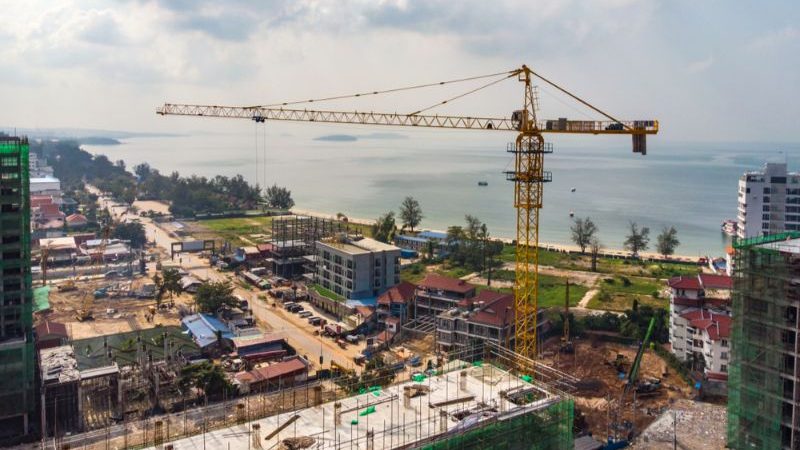
Construction in Sihanoukville. Photo by diy13.
Unfortunately this is the story of overtourism, repeated like-for-like all over the world. The backdrop changes, but the plot is depressingly familiar. It starts with backpackers and bohemian, adventure types, then tour companies (like us) open up new routes and itineraries, making it easier and cheaper for travellers to visit. Local companies respond by investing in tourism infrastructure, building new hotels and resorts, and then there’s a flash point – maybe the destination gets featured in a Top 10 list, or some Hollywood studio decides to shoot a movie there (see Thailand’s Kho Phi Phi) – and demand suddenly soars way, way above supply. Travellers swarm in unsustainable numbers, overwhelming the locals and triggering all sorts of unintended consequences (crime, pollution and environmental damage being the big three). It’s happened in Croatia, Thailand, Venice, Barcelona and now (unfortunately) Sihanoukville.
RELATED: HOW TO CHOOSE A RESPONSIBLE TOUR OPERATOR
Sihanoukville today is almost unrecognizable. More than 70 individual casinos have been built here in the last three years alone. There are even plans underway for a new $1 billion, 65-hectare Chinese-Malaysian resort, Wisney World, set to feature “water parks, hotels, casinos, malls, gardens and churches” (according to the Phnom Penh Post.) Much of Ream National Park has been logged and cleared for development, and there’s a four-lane highway being forged between Sihanoukville and Phnom Penh. The town itself is now an almost-permanent construction zone. Bricks and construction materials litter the streets, the crime rate is growing, and Sihanoukville’s postcard beaches are now choked with plastic bags. The economic gap between the city’s rich and poor is widening – fast.
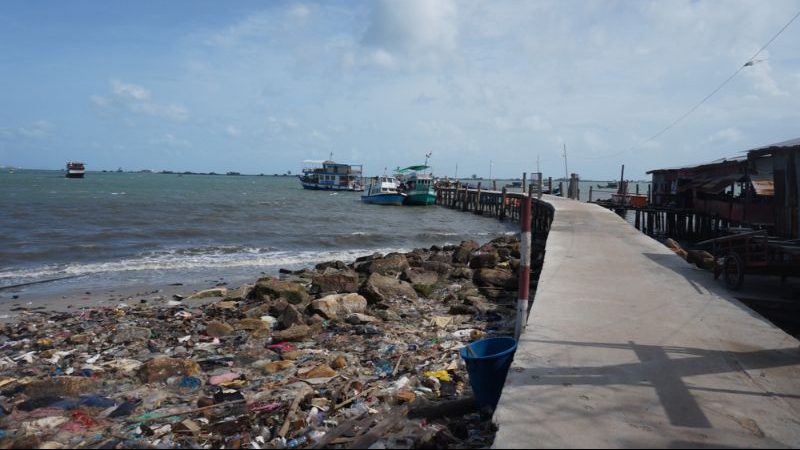
Rubbish litters the town. Photo by TheWalkingEye.
The cruellest irony of overtourism is the direct correlation between beauty and suffering: if Sihanoukville had been slightly less perfect, its beaches less isolated and sun-kissed, its waters less photogenic, tourists might never have come here, and developers would have nothing to sell. As one of the tour companies that opened Sihanoukville to the world, we have to take some of the responsibility for its downfall. It’s one of the reasons we’re pushing so hard for a new kind of travel: ‘undertourism’.
This year we released our first ever Not Hot List – a compilation of destinations that are on pretty much nobody’s dream itinerary. But they should be. Out-of-the-way spots that have never even seen a Starbucks espresso machine. We’re trying to alleviate the negative effects of tourism while sharing and spreading its economic benefit – introducing travellers to new communities in a sustainable way.
RELATED: A GUIDE TO BATTAMBANG, CAMBODIA’S MOST UNDERRATED CITY
“We must be cautious of the effect that travel has on the health and wellness of locals and of the destination,” says Intrepid CEO James Thornton. “At Intrepid, we hold the traveller and the destination in equal respect, and believe one need not be sacrificed for the other.”
In Cambodia’s case, that means saying goodbye to Sihanoukville (for now) and looking to smaller towns like Kampong Cham, Kampong Chhnang, Battambang and Kampot instead. You can check out our new itineraries here.
In amending our itineraries to no longer include Sihanoukville, we considered the impact this would have on local businesses, but Cambodian-owned businesses are now a rarity in Sihanoukville , as most hotels and restaurants are operated by foreign investors. We weighed this up against the experience our customers were expecting in Cambodia, and chose to include lesser-known towns throughout Cambodia’s countryside instead.
We hope the travel industry – us included – can learn from the mistakes of the past. We hope that Sihanoukville can recover and bounce back. It’ll probably never be the sleepy town that it once was, but that doesn’t mean it can’t be great again. There’s no reason that travel and sustainable, patient development can’t go hand in hand. There’s no reason travel can’t enrich local communities, instead of overwhelming them. There’s no reason it can’t start right now.
Explore our full range of small group adventures in Cambodia now.
Feature photo by Stephen Parry.

